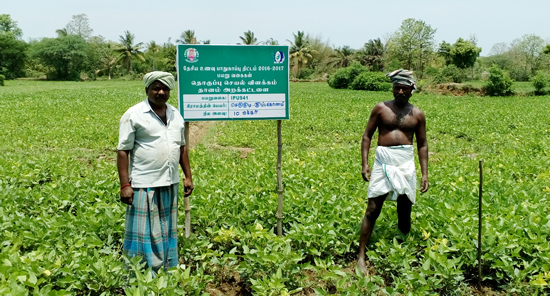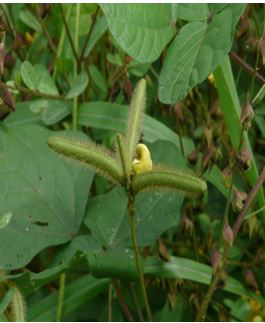
Case8-September-2017
“Pulses are the food of the future. They are the future of better nutrition… the future of improved health… and the future of sustainable food.”

Pulses are good for health and are very nutritious. They are very low in fat, high source of protein and full of vitamins and minerals. They are being grown and consumed for over 11,000 years. Pulses cultivation is carried out in 173 countries, making pulses one of the common crops across nations. Growing pulses also promotes sustainable agriculture, helps decrease greenhouse gases, and fixes nitrogen in soil thereby increasing soil health. Cultivation of pulses requires less water than other crops. Pulses are good for all ages. Above all, they are easy to cook. It is hence the 68th UN general assembly declared 2016 as the International Year of pulses.
The Tanjore Cauvery delta is well-known for its paddy base. It is the prime source of livelihood for the whole
delta stretch for years. However, frequent droughts and inadequate water availability in the reservoir has also added strain to having successful crop yield. From three sowings in a year, cultivation has shifted to at least one good crop in a year. Agriculture has become an unprofitable activity and the farmers were in a dilemma whether to continue its cultivation or not.
In this context, the National Food Security Mission (NFSM) partnered with DHAN Foundation to facilitate demonstration of pulses farming. This project is being implemented by DHAN Foundation through the Agriculture department in Kumbakonam, Thiruvidaimaruthur and Thiruppananthal blocks of Thanjavur district of Tamil Nadu. Through this intervention, we support 318 farmers to conduct demonstration in 300 hectares.
The major programme components of this initiative are to identify a select set of farmers to conduct the demonstration in their field. Then awareness is created among the demonstration plot farmers, providing them technology guidance and support to take up the crop in their field. Need-based training programmes are conducted to create shared understanding and events and agricultural festivals organised to propagate the learning and success to the farm fraternity.
To generate common understanding among the implementing staffs, the regional office organised orientation programme for the field staff. The team members were briefed about the project and the expected activities in the field. Subsequently, through the Assistant Director Agriculture’s office (ADAO) of the Kumbakonam, Thiruvidaimaruthur and Thiruppananthal blocks, field visits were conducted to for interaction in the field. This orientation visit helped the participants gain awareness about the farmers’ perspective and potential activities.
The target group in this initiative are the farmers having more than one acre of own land and interested in cultivating pulses followed by paddy. We selected twelve villages in the three blocks to create clusters to make the initiative viable and assist in the sustainability of the activity to the farmers.

Black gram (Vigna mungo) is a widely grown legume, belonging to the family Fabaceae and assumes considerable importance in terms of food and nutritional security. Black gram is very nutritious as it contains high levels of protein. Black gram complements the essential amino acids present in most cereals and plays an important role in the diets of the people of Nepal and India. Black gram has been shown to be useful in mitigating elevated cholesterol levels.
Black gram is a common crop in the delta belt as a post harvest crop after paddy. The yield of the local variety being cultivated is found to be lesser compared to the IPU 941 seeds. These hybrid seeds are known for their better yield and pest resistance. Hence, it has been decided to introduce the IPU 941 seeds among the farmers. It is expected to give more yield, thereby increasing the profits of the farmers.
The field visits provided the leads for identification and selection of villages. In consultation with the ADA office, the 12 proposed intervention villages were indentified for the black gram demonstration. These villages were selected from three clusters, so as to distinguish the differences in yield and adaptability. The identified villages are Nachiyarkoil, Mathur, Melamathur, Enanallur, Sembiyavarambal, Vanduvanchery, Thandalam, Thanthanthottam, Krishnapuram villages of Thiruvidaimaruthur block and Serukudi, Mela Kattur and Keela Kattur villages of Thiruppananthal block.
Before the identification of beneficiaries, we conducted sensitisation programme in the three villages (Nachiyarkoil, Enanallur and Sembiyavarambal) to understand the potential, interest level of the community, their needs and to identify farmers inteested in the pulse demonstration. This gave the necessary orientation and awareness about the project as well as the approach to be undertaken in the villages. It gave the project team the ideal space to get introduced to the community and understand their expectations.
The community also became aware about the project through these interactions. Pamphlets describing the objective of the initiative, information about the gains of IPU 941, and details of the scheme subsidy from the agriculture department were distributed to the villagers.
After the selection of the intervention villages and the community engagement awareness programmes, we identified 318 interested farmers from these 12 villages. Efforts were made to ensure participation of small and marginal farmers among the 318 farmers. Based on interest and area of cultivation, a list of farmers was generated with consultation with the local community and ADA office. Once the list of farmers was prepared, we asked the farmers to submit the Patta and Chitta Adangal with VAO certificate on cultivation. These farmers were termed as isolation farmers.
Then, the farmers were briefed about the advantage of the new variety, its better yield, the yellow mosaic disease tolerance feature, and its lower water needs. A quantity of 20 kilogram of seeds was distributed for one hectare of land at a total subsidy of Rs. 7,500 from the ADA office. Seeds and bio fertilizers were distributed to the farmers by the department through Depot. The other subsidies were released to their account on submission of bills.
The demonstrations were conducted in 300 hectares of land belonging to 318 farmers after procuring all documents from them. The ADA office facilitated field visits to farms and guided the farmers in the field to clarify doubts and in application of manure and pesticides.
The demonstrative initiative carried out in 300 hectares has yielded good results and the farmers were happy after receiving good yields. Yield assessment was done by visiting the farmers field and also through Focused Group Discussion (FDG). In the FDG the farmers expressed that the variety IPU 941 is resistant to yellow mosaic. It is growing up to knee height in irrigated condition and is flowering for 2-3 times resulting in good yield of 1200 kg per acre and the crop lasts for 90 days in field to give completely matured pods.
Our field assessment also shows that in the rice fallow pulse the population is not maintained properly and has given yield of 500 kg/ acre. But in irrigated sole crop population, growth, flowering and yield are very good up to 1,200 kg per acre, especially in Kumbakonam block around Serukudi. This is 40%-150% higher than the regular average yield. The bean quality was also so good that it fetched Rs.63/- per kilogram against Rs.50- 55 for the produce of the earlier variety during the same year. Thus the crop intervention initiative has helped the farmers to obtain higher yields with better price raising the hopes of the farmers in carrying out agriculture profitably.